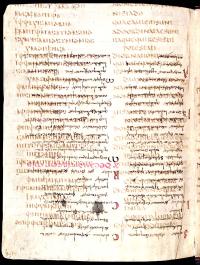The manuscript Cod. Guelf. 64 Weiss. is one of the oldest and most significant historical texts in Germany. Its oldest sections date from the late fifth century, while the main text was written in northern Italy in the early eighth century. The codex is one of the two most important complete textual witnesses to the encyclopaedia by Isidore of Seville (who died in the year 636). The manuscript largely consists of the sheets containing this main text on top of erased texts, which were the work of seven or eight previous authors in late antiquity. Among these works, which are still legible despite having been erased, are the earliest surviving evidence of the Greek medic Galen, parts of Evangelion and Bible manuscripts in Greek and Latin, one of the oldest texts of the ‘Ambrosiaster’ commentary on St Paul’s epistles and, above all, the Gothic and Latin text of parts of the Epistle to the Romans.
The aim in producing a digital edition of this manuscript was not primarily to create a philological edition of the texts it contains but rather to aid research and provide examples of innovative techniques used in publishing and editorial work. There is a particular focus on the relationship between the various texts, the connection between text and image and the potential for automation.
Funding: Gerda Henkel Stiftung, Düsseldorf
Project participants: Torsten Schaßan (project supervisor), Stefanie Gehrke (team member), Fabian Schwabe (team member)

